Miroirs en bronze doré et pierres du Rhin offerts par l'impératrice Marie-Thérèse à Marie-Antoinette ?
LE FORUM DE MARIE-ANTOINETTE :: Le patrimoine de Marie-Antoinette :: Le mobilier et les arts décoratifs
Page 1 sur 1
 Miroirs en bronze doré et pierres du Rhin offerts par l'impératrice Marie-Thérèse à Marie-Antoinette ?
Miroirs en bronze doré et pierres du Rhin offerts par l'impératrice Marie-Thérèse à Marie-Antoinette ?
Prochainement proposés aux enchères, à l'occasion de la vente...
 Sotheby's Paris - Hôtel Lambert, une collection princière
Sotheby's Paris - Hôtel Lambert, une collection princière
A pair of Austrian neoclassical gilt-bronze and rhinestone mirrors possibly supplied to Marie-Antoinette
Vienna, circa 1780
(plates replaced)
Height 27¼in.; width 20 in.; 69 cm; 51 cm
Provenance :
Possibly Marie-Antoinette, Queen of France ; Michel Meyer, Paris ; Private Collection ; Graff, Paris, 2015.
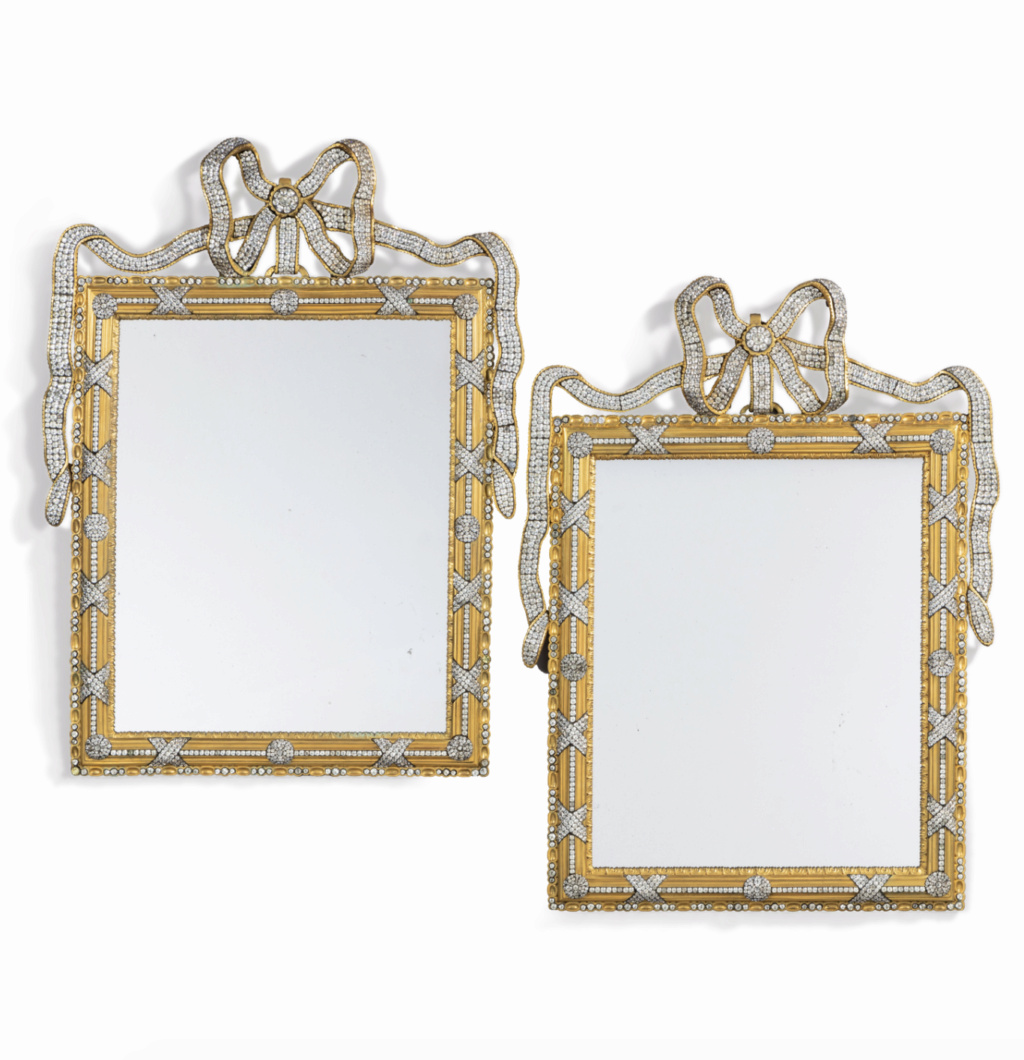
Catalogue note
This exquisite pair of mirrors is a rare example of innovative Viennese neoclassical metalwork design of the late 18th century. The frames previously had plates engraved with the cypher of Marie-Antoinette, and may have been a gift from Empress Maria Theresa of Austria to her daughter, who had married the French dauphin in May 1770 and became Queen of France when her husband acceded to the throne as Louis XVI in 1774.
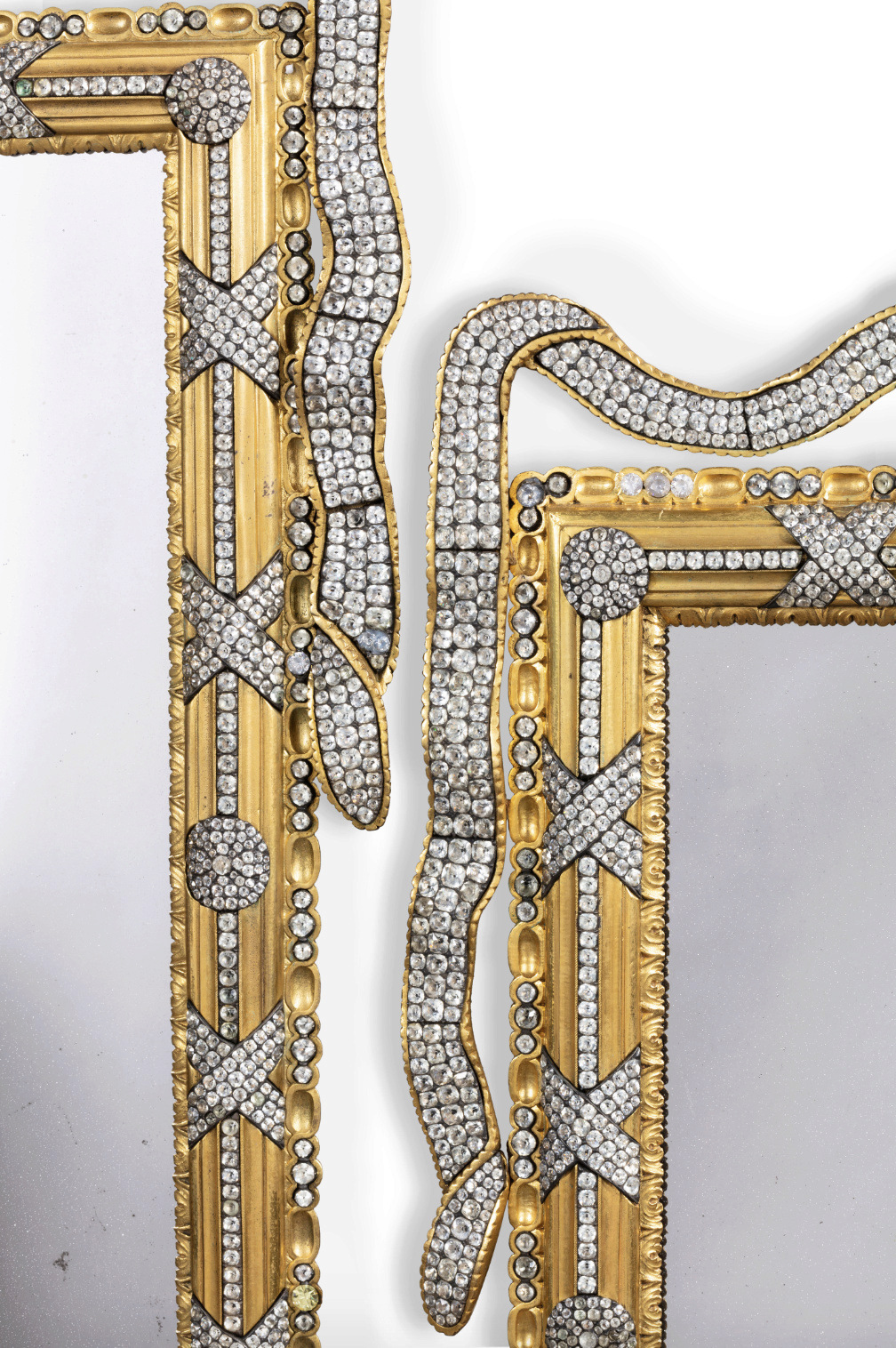
In the second half of the 1700s, the Habsburg monarchy undertook a sustained campaign to improve the instruction and training of artists in both the fine and applied arts, with the specific aim of raising the profile of Vienna as an artistic capital independent of other European centres like Paris and London. This was spearheaded by the State Chancellor, Count Wenzel Anton von Kaunitz-Rietberg (1711-1794), who had served as ambassador to the French court from 1750 to 1752.
A Schule für Fabrikanten (School of Manufacturing) was established in 1758, which would later be merged with the Graveurakademie (Academy of Engravers) in 1772, and incorporated the following year with other teaching institutions of painting, sculpture and applied arts to create an umbrella Royal and Imperial Akademie der bildenden Künste, modelled on the royal academies founded in France and England but more comprehensive in scope (see Wolfram Koppe, Vienna 1780. An Imperial Silver Service Rediscovered, New York, Metropolitan Museum 2010, p.19-20).

In the Habsburg dominions the guild regulations were more flexible than in other regions, so a goldsmith had the freedom to work in metals other than just gold and silver. Many of them turned their hand to working in bronze and other materials, leading to the development of a distinctly Viennese style of metal objects during the neoclassical period.
One of the most accomplished examples of this is the extraordinary guéridon with top of petrified wood set in a frame and tripod stand of polished steel and gilt bronze executed by the court goldsmith Anton Matthias Domanöck (1713-1779) (Château de Versailles, exhibited Marie-Antoinette, Galeries nationales du Grand Palais, Paris 2008, cat. no. 239).
This was commissioned by Marie-Antoinette’s older sister Maria Christina, Duchess of Saxe-Teschen, and delivered to Versailles as a gift to the dauphine in the year of her marriage.

Guéridon, 1770
Par Anton-Mathias-Joseph Domanöck (bronzier)
Acier, bronze ciselé et doré, bois pétrifié, noyer, acajou, ébène
Image : RMN-GP (Château de Versailles) / Daniel Arnaudet / Jean Schormans
 Lire notre sujet : Meubles et objets du XVIIIe siècle en acier et bronze doré
Lire notre sujet : Meubles et objets du XVIIIe siècle en acier et bronze doré
Domanöck had been director of the Graveurakademie and counted among his pupils several members of the Würth family, who were the leading dynasty of goldsmiths in 18th century, chief among them Ignaz Joseph Würth (1742-1792, master goldsmith in 1770).
Würth is known to have worked in gilt bronze as well as silver, as evidenced by his signature on the gilt bronze mounts on a pair of petrified wood vases commissioned by Maria Theresa in 1780 as a gift for her son-in-law Louis XVI and delivered to Versailles the following year (Château de Versailles, illustrated in Pierre Verlet, Les bronzes dorés français du XVIIIe siècle, Paris 1987, fig. 261 p. 237 and exhibited Grand Palais 2008, cat. no. 240).
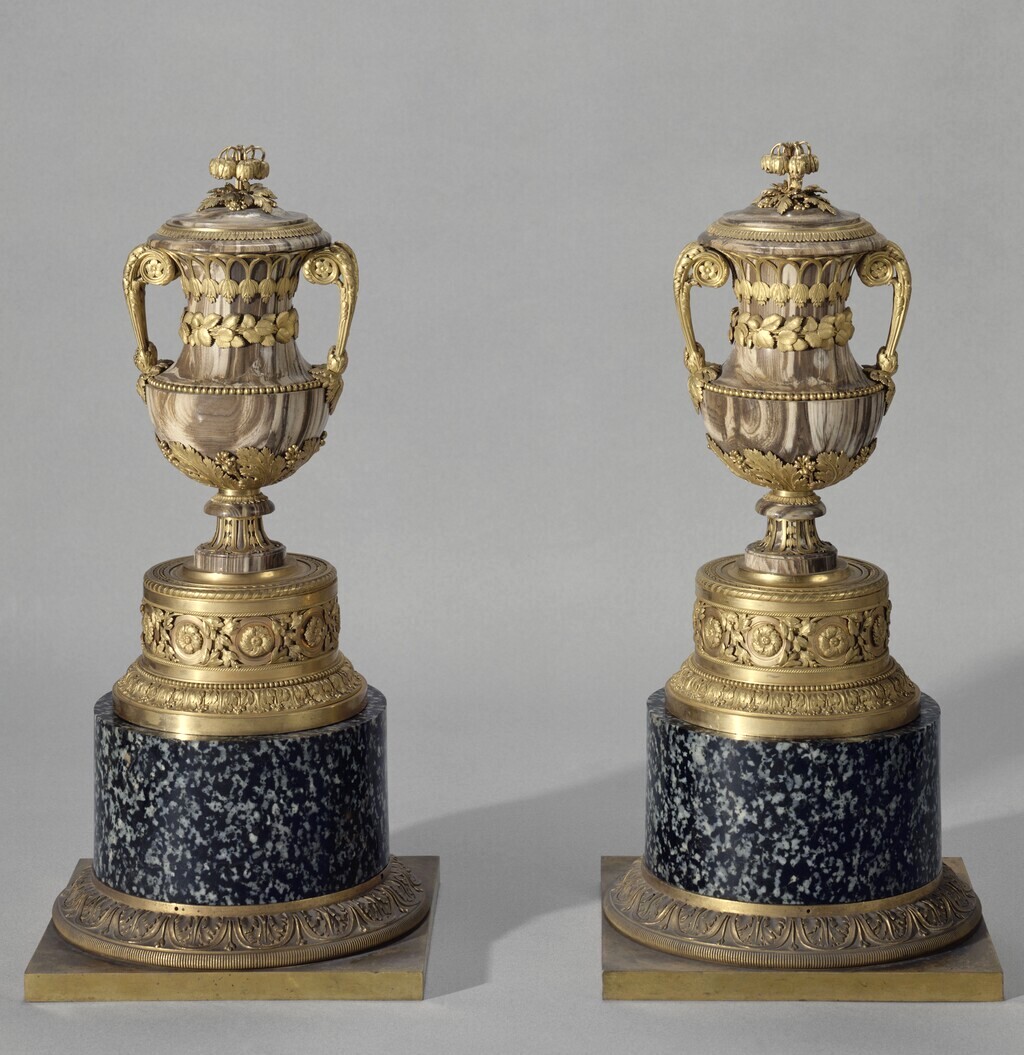
Paire de vases en bois pétrifié, legs de l'impératrice Marie-Thérèse à son gendre Louis XVI
Ignaz-Joseph Würth (orfèvre)
Bois pétrifié, bronze ciselé et doré, granit vert, 1780
Louis XVI reçut deux vases de bois pétrifié envoyé de Vienne en février 1781 qu'il disposa dans sa salle à manger intérieure.
Image : RMN-GP (Château de Versailles) / Daniel Arnaudet
Voir notre sujet : Collections de Marie-Antoinette et Louis XVI d'objets et meubles en bois pétrifié
Viennese authorship, possibly the Würth family, is also likely for the gilt bronze mounts on a group of Oriental porcelain in the Princes of Liechtenstein collection (illustrated in Koeppe, p. 23-25).
Ignaz Würth is also a probable candidate for the maker of an important gilt bronze and rhinestone vase with an enamelled plaque bearing the initials MA which may correspond to the ‘urne avec la médaille de Marianne’ known to have been offered to Marie-Antoinette in 1770 by another of her sisters, Archduchess Marie-Anne (sold Sotheby’s Paris 19 November 2019, lot 72).
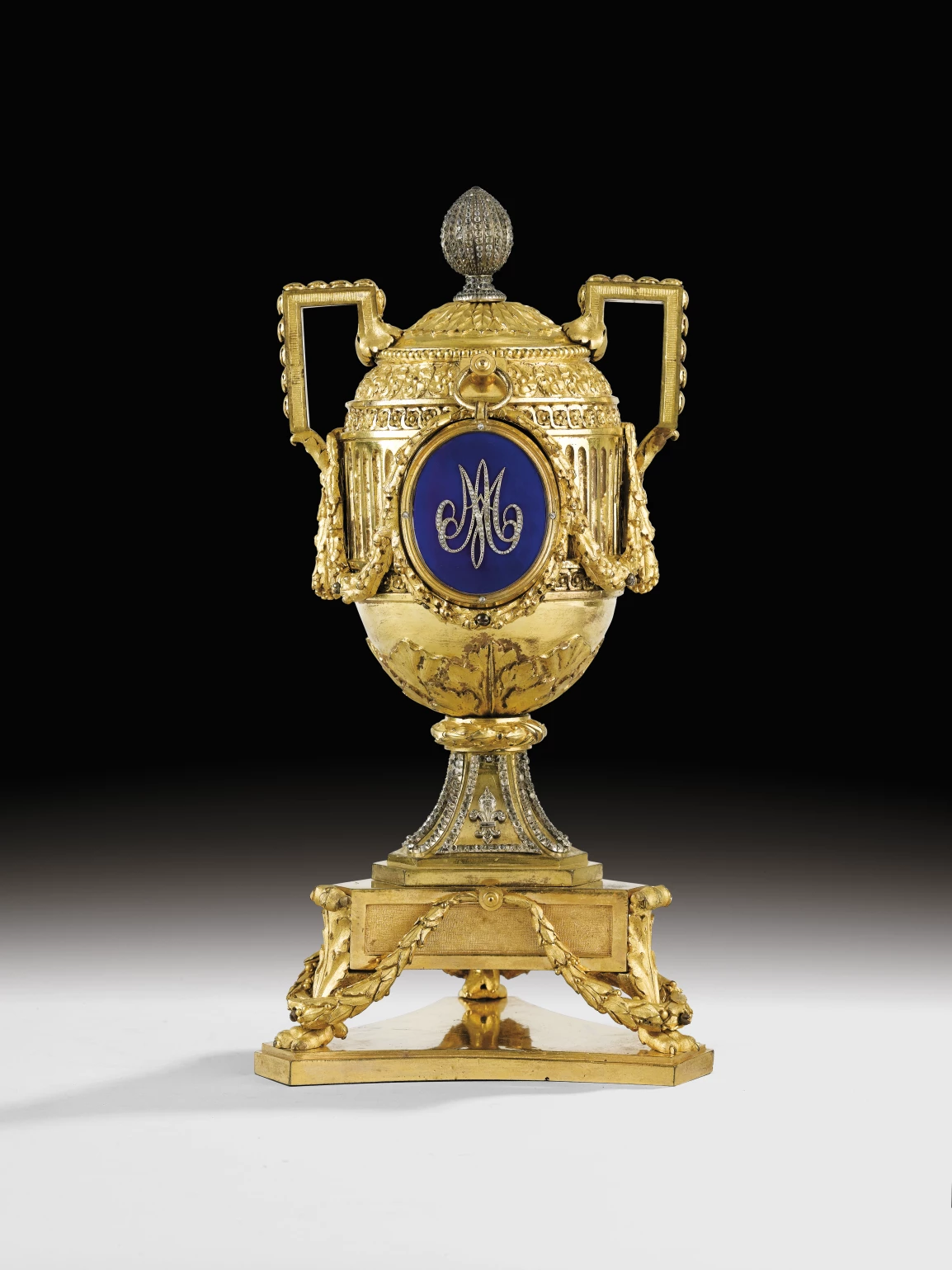
This object shares the same highly refined design and quality of execution as the offered pair of mirrors, as well as the unusual combination of gilt bronze and rhinestones, suggesting both items emanate from the same workshop.
Stylistically they are similar to Ignaz Würth’s masterpiece, the extensive silver dinner service commissioned by the Duke and Duchess of Saxe-Teschen in 1779-1782 when they assumed the governorship of the Austrian Netherlands in Brussels.
The presence of the MA monogram also strongly supports the theory that both the vase and mirrors were commissioned expressly for Marie-Antoinette.
Although precise descriptions are rare, the extensive correspondence between the Austrian ambassador to France Count Mercy d’Argenteau and Empress Maria Theresa, and between Marie-Antoinette and the Empress, reveal there were frequent exchanges of gifts between the two courts during the 1770s up until Maria Theresa’s death in 1780.
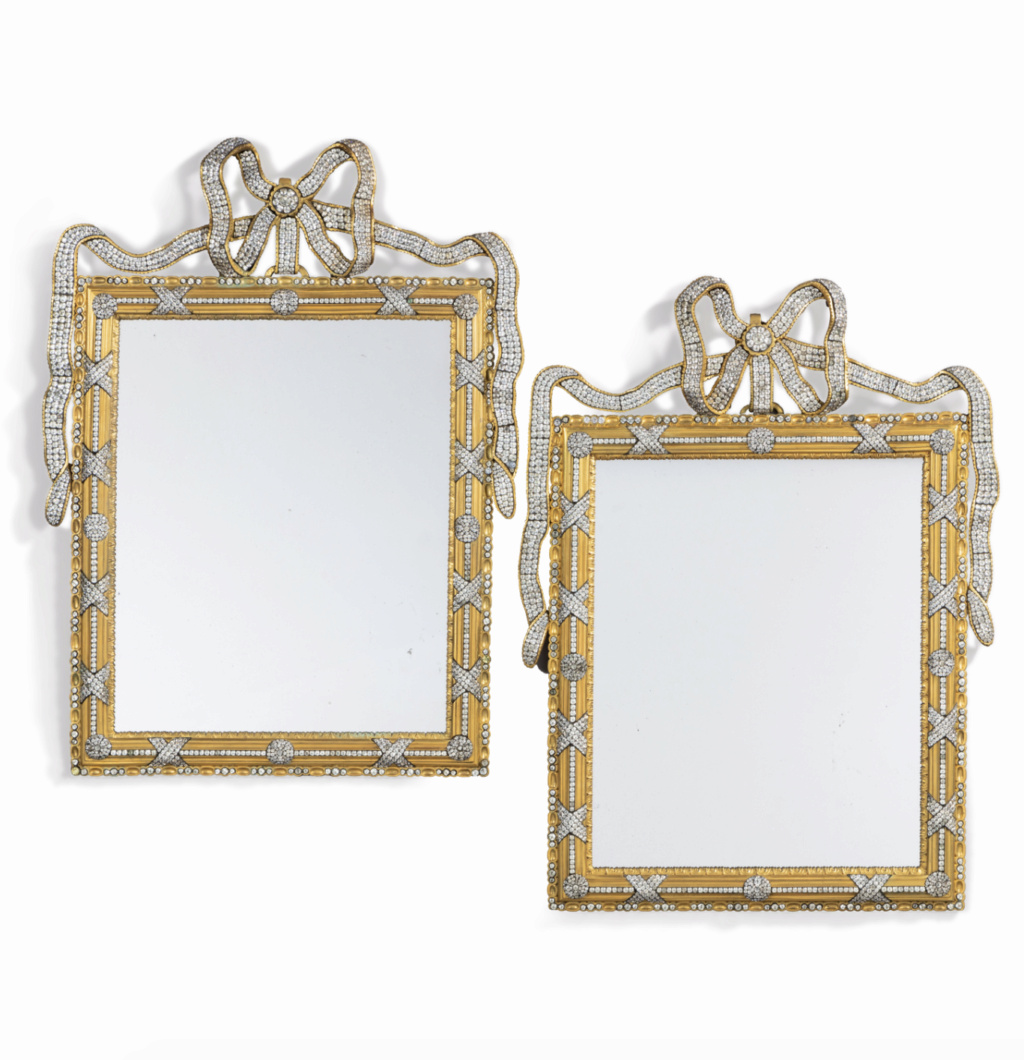
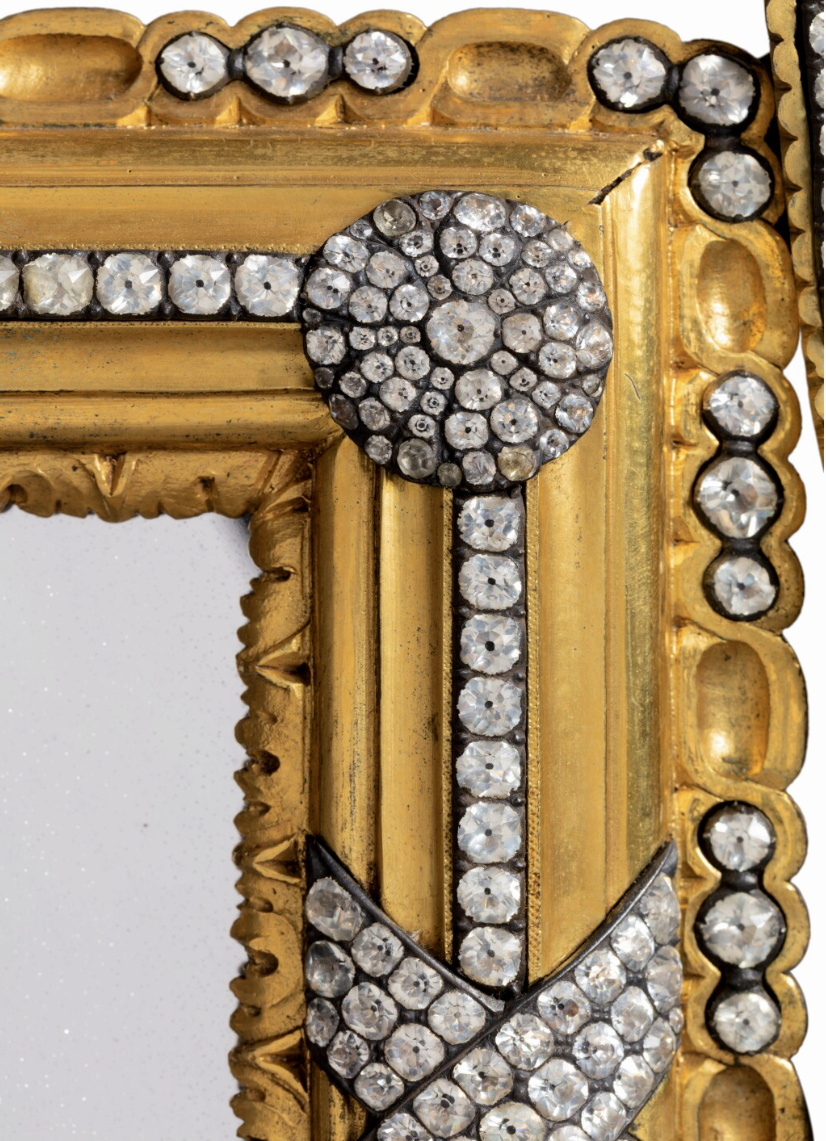
During the Revolution Marie-Antoinette entrusted many items from her personal collection to the marchands-merciers Daguerre and Lignereux for safekeeping after she was compelled to leave Versailles in October 1789. These were inventoried by the Revolutionary authorities in December 1793 who noted in addition to the Japanese lacquer objects the Queen had inherited from her mother the presence of a numerous ‘meubles et bijoux, faits à Vienne, […] montés en or, vermeil ou en bronze doré’ (A. Tuetey, ‘Inventaire des laques anciennes et des objets de curiosité de Marie-Antoinette confiés à Daguerre et Lignereux, Marchands-Bijoutiers le 10 octobre 1789 [26 frimaire an II]’, Archives de l’Art Français, t. VIII 1916, p. 288, 296).
This significant quantity of gifts sent from Vienna to Marie-Antoinette at Versailles, a reflection of the symbiotic relationship between the Empress and a daughter who arrived in France at the age of 14, only served to reinforce the impression that the Queen was inherently a foreigner disloyal to her adopted country - l’autrichienne - and contribute to a deep unpopularity that would ultimately prove fatal.

* Source et infos complémentaires : Sotheby's Paris - Hôtel Lambert, une collection princière
A pair of Austrian neoclassical gilt-bronze and rhinestone mirrors possibly supplied to Marie-Antoinette
Vienna, circa 1780
(plates replaced)
Height 27¼in.; width 20 in.; 69 cm; 51 cm
Provenance :
Possibly Marie-Antoinette, Queen of France ; Michel Meyer, Paris ; Private Collection ; Graff, Paris, 2015.

Catalogue note
This exquisite pair of mirrors is a rare example of innovative Viennese neoclassical metalwork design of the late 18th century. The frames previously had plates engraved with the cypher of Marie-Antoinette, and may have been a gift from Empress Maria Theresa of Austria to her daughter, who had married the French dauphin in May 1770 and became Queen of France when her husband acceded to the throne as Louis XVI in 1774.

In the second half of the 1700s, the Habsburg monarchy undertook a sustained campaign to improve the instruction and training of artists in both the fine and applied arts, with the specific aim of raising the profile of Vienna as an artistic capital independent of other European centres like Paris and London. This was spearheaded by the State Chancellor, Count Wenzel Anton von Kaunitz-Rietberg (1711-1794), who had served as ambassador to the French court from 1750 to 1752.
A Schule für Fabrikanten (School of Manufacturing) was established in 1758, which would later be merged with the Graveurakademie (Academy of Engravers) in 1772, and incorporated the following year with other teaching institutions of painting, sculpture and applied arts to create an umbrella Royal and Imperial Akademie der bildenden Künste, modelled on the royal academies founded in France and England but more comprehensive in scope (see Wolfram Koppe, Vienna 1780. An Imperial Silver Service Rediscovered, New York, Metropolitan Museum 2010, p.19-20).

In the Habsburg dominions the guild regulations were more flexible than in other regions, so a goldsmith had the freedom to work in metals other than just gold and silver. Many of them turned their hand to working in bronze and other materials, leading to the development of a distinctly Viennese style of metal objects during the neoclassical period.
One of the most accomplished examples of this is the extraordinary guéridon with top of petrified wood set in a frame and tripod stand of polished steel and gilt bronze executed by the court goldsmith Anton Matthias Domanöck (1713-1779) (Château de Versailles, exhibited Marie-Antoinette, Galeries nationales du Grand Palais, Paris 2008, cat. no. 239).
This was commissioned by Marie-Antoinette’s older sister Maria Christina, Duchess of Saxe-Teschen, and delivered to Versailles as a gift to the dauphine in the year of her marriage.

Guéridon, 1770
Par Anton-Mathias-Joseph Domanöck (bronzier)
Acier, bronze ciselé et doré, bois pétrifié, noyer, acajou, ébène
Image : RMN-GP (Château de Versailles) / Daniel Arnaudet / Jean Schormans
Domanöck had been director of the Graveurakademie and counted among his pupils several members of the Würth family, who were the leading dynasty of goldsmiths in 18th century, chief among them Ignaz Joseph Würth (1742-1792, master goldsmith in 1770).
Würth is known to have worked in gilt bronze as well as silver, as evidenced by his signature on the gilt bronze mounts on a pair of petrified wood vases commissioned by Maria Theresa in 1780 as a gift for her son-in-law Louis XVI and delivered to Versailles the following year (Château de Versailles, illustrated in Pierre Verlet, Les bronzes dorés français du XVIIIe siècle, Paris 1987, fig. 261 p. 237 and exhibited Grand Palais 2008, cat. no. 240).

Paire de vases en bois pétrifié, legs de l'impératrice Marie-Thérèse à son gendre Louis XVI
Ignaz-Joseph Würth (orfèvre)
Bois pétrifié, bronze ciselé et doré, granit vert, 1780
Louis XVI reçut deux vases de bois pétrifié envoyé de Vienne en février 1781 qu'il disposa dans sa salle à manger intérieure.
Image : RMN-GP (Château de Versailles) / Daniel Arnaudet
Voir notre sujet : Collections de Marie-Antoinette et Louis XVI d'objets et meubles en bois pétrifié
Viennese authorship, possibly the Würth family, is also likely for the gilt bronze mounts on a group of Oriental porcelain in the Princes of Liechtenstein collection (illustrated in Koeppe, p. 23-25).
Ignaz Würth is also a probable candidate for the maker of an important gilt bronze and rhinestone vase with an enamelled plaque bearing the initials MA which may correspond to the ‘urne avec la médaille de Marianne’ known to have been offered to Marie-Antoinette in 1770 by another of her sisters, Archduchess Marie-Anne (sold Sotheby’s Paris 19 November 2019, lot 72).

This object shares the same highly refined design and quality of execution as the offered pair of mirrors, as well as the unusual combination of gilt bronze and rhinestones, suggesting both items emanate from the same workshop.
Stylistically they are similar to Ignaz Würth’s masterpiece, the extensive silver dinner service commissioned by the Duke and Duchess of Saxe-Teschen in 1779-1782 when they assumed the governorship of the Austrian Netherlands in Brussels.
The presence of the MA monogram also strongly supports the theory that both the vase and mirrors were commissioned expressly for Marie-Antoinette.
Although precise descriptions are rare, the extensive correspondence between the Austrian ambassador to France Count Mercy d’Argenteau and Empress Maria Theresa, and between Marie-Antoinette and the Empress, reveal there were frequent exchanges of gifts between the two courts during the 1770s up until Maria Theresa’s death in 1780.


During the Revolution Marie-Antoinette entrusted many items from her personal collection to the marchands-merciers Daguerre and Lignereux for safekeeping after she was compelled to leave Versailles in October 1789. These were inventoried by the Revolutionary authorities in December 1793 who noted in addition to the Japanese lacquer objects the Queen had inherited from her mother the presence of a numerous ‘meubles et bijoux, faits à Vienne, […] montés en or, vermeil ou en bronze doré’ (A. Tuetey, ‘Inventaire des laques anciennes et des objets de curiosité de Marie-Antoinette confiés à Daguerre et Lignereux, Marchands-Bijoutiers le 10 octobre 1789 [26 frimaire an II]’, Archives de l’Art Français, t. VIII 1916, p. 288, 296).
This significant quantity of gifts sent from Vienna to Marie-Antoinette at Versailles, a reflection of the symbiotic relationship between the Empress and a daughter who arrived in France at the age of 14, only served to reinforce the impression that the Queen was inherently a foreigner disloyal to her adopted country - l’autrichienne - and contribute to a deep unpopularity that would ultimately prove fatal.

* Source et infos complémentaires : Sotheby's Paris - Hôtel Lambert, une collection princière

La nuit, la neige- Messages : 18138
Date d'inscription : 21/12/2013
 Sujets similaires
Sujets similaires» Garniture de porcelaine de Chine et bronze doré de Marie-Antoinette
» Instructions de Marie-Thérèse à Marie-Antoinette : Règlement à lire tous les mois
» Marie-Joséphine de Savoie, comtesse de Provence
» Le goût de Marie-Antoinette pour la porcelaine de Sèvres, décors à effets de perles et pierres précieuses
» Marie-Thérèse Sallantin, responsable de la garde-robe aux atours de Marie-Antoinette, puis commissionnaire au Temple
» Instructions de Marie-Thérèse à Marie-Antoinette : Règlement à lire tous les mois
» Marie-Joséphine de Savoie, comtesse de Provence
» Le goût de Marie-Antoinette pour la porcelaine de Sèvres, décors à effets de perles et pierres précieuses
» Marie-Thérèse Sallantin, responsable de la garde-robe aux atours de Marie-Antoinette, puis commissionnaire au Temple
LE FORUM DE MARIE-ANTOINETTE :: Le patrimoine de Marie-Antoinette :: Le mobilier et les arts décoratifs
Page 1 sur 1
Permission de ce forum:
Vous ne pouvez pas répondre aux sujets dans ce forum